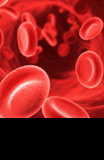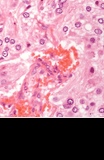Oxford named Focused Ultrasound Centre of Excellence

The University of Oxford has been designated a Centre of Excellence in Focused Ultrasound, thanks in part to the facilities and expertise located at Oxford University Hospitals (OUH) NHS Foundation Trust.
Oxford becomes the fifth Centre of Excellence in Europe to receive this accolade from the Focused Ultrasound Foundation and the eleventh worldwide.
The Centre of Excellence will be co-directed by Professor Constantin Coussios, Director of the Institute of Biomedical Engineering, and Dr Paul Lyon, Senior Clinical Research Fellow in the Nuffield Department of Surgical Sciences and OUH Consultant Radiologist.
Established in 2009, the Centers of Excellence programme recognises exceptional focused ultrasound sites throughout the world. The Centres serve as hubs for collaboration, bringing together academia, industry and the US-based Foundation to champion therapeutic ultrasound technology in innovative ways.
"We are honoured to recognise the University of Oxford as one of the leading focused ultrasound sites in the world," said Neal F Kassell, MD, Founder and Chairman of the Focused Ultrasound Foundation.
"The team is engaging in critical basic science and translational work that will reach more patients in the United Kingdom, Europe and globally, saving lives and accelerating the development and adoption of focused ultrasound technology."
Focused ultrasound research has been a hallmark of the Oxford ecosystem since 2004. "Oxford has been one of the leading therapeutic ultrasound centres in the United Kingdom over the last 20 years," said David Cranston, emeritus associate professor of surgery, founding clinical director of the Oxford High Intensity Focused Ultrasound (HIFU) unit and president of the International Society of Minimally Invasive and Non-invasive Medicine (ISMINIM) from 2017-2023.
"We are absolutely delighted to be having a closer cooperation with the Focused Ultrasound Foundation in the United States through this award and in the growth of the Focused Ultrasound Foundation in the United Kingdom. We look forward to promoting the technology for the benefit of patients," he said.
Professor Cranston worked with David Highton, the then Chief Executive of the Oxford Radcliffe Hospitals NHS Trust, Chongqing Medical University and the HAIFU company in China to achieve the launch of a clinical HIFU research facility in Oxford in 2002.
After he oversaw the first European trials of extra-corporeal HIFU for liver and kidney ablation, the Oxford group were able to get CE-marking for tumour therapy in 2005 and this approval has since been used by other centres throughout Europe.
Professor Feng Wu is the lead Clinical HIFU Consultant who has worked on various clinical HIFU trials with the wider team at the OUH since 2002, and he is a world authority on clinical HIFU and its immunological effects.
In 2009, Professor Fergus Gleeson was instrumental helping to place an upgraded machine as an integral part of OUH's newly built Cancer Hospital. The device in the Churchill Hospital's Radiology Department is strategically located between the state-of-the-art operating theatres, the department of oncology and the Oncological Clinical Trials Office.
Since his arrival in Oxford in 2011, Professor Coussios has been instrumental in the ongoing development of this technology, running a large research group leading the preclinical work and overseeing a number of innovative clinical trials including targeted drug delivery for tumour treatment.
HIFU has power 10,000 times that of ordinary ultrasound and can remove benign uterine fibroids and malignant tumours from outside the body using focused ultrasound alone, without harming the overlying structures.
The main clinical HIFU device in Oxford is now in use for more routine gynaecological work including uterine-sparing ablation of symptomatic uterine fibroids, as well as the advanced clinical research programme that has been recognised by the Focused Ultrasound Foundation.
"Since the invention of Passive Acoustic Mapping for clinical cavitation imaging in 2007, over 35 patents have been filed and four new companies formed to translate novel ultrasound-responsive agents and treatment or monitoring techniques for drug delivery, sonodynamic therapy, transdermal vaccination, antimicrobial therapies, neuromodulation and immune-stimulation," said Professor Coussios.
"Oxford's broadband blend of basic science, clinical and commercial translation creates a unique training environment for the next generation of leaders and innovators in therapeutic ultrasound, whom we hope to continue developing and training with the Focused Ultrasound Foundation's continued support."
Dr Paul Lyon, who conducted the first-in-human clinical trial of ultrasound-triggered drug delivery to the liver, added: "More than 700 patients have been screened for ablative or drug-delivery focused ultrasound treatments at Oxford, with some 250 patients treated to date.
"After having conducted the very first clinical trials of ultrasound-enhanced drug delivery outside the brain, we are presently advancing and pioneering clinical therapeutic ultrasound treatments, ranging from ablative techniques for pancreatic tumours and soft tissue sarcomas, to enhanced drug delivery for metastatic colorectal tumours in the liver, and ultrasound-stimulated neuromodulation and immuno-oncology."
The progression to Centre of Excellence would not have been possible without the support of OUH and the efforts and dedication of the many academics, clinicians and radiology, anaesthetic, nursing and theatre staff at the OUH who have all played a valuable part in treating patients with a wide variety of pathologies including a range of difficult-to-treat cancers.
Pictured here are Dr Paul Lyon, Professor Feng Wu and Professor David Cranston with a patient in the HIFU unit in Oxford.
Credit: John Cairns, University of Oxford




























































